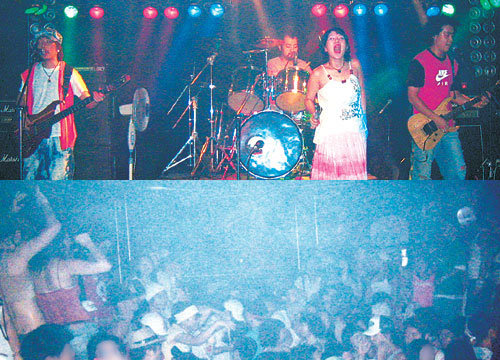Hongdae, the Mecca of Indie Culture Is Deteriorating
Hongdae, the Mecca of Indie Culture Is Deteriorating
Posted August. 06, 2005 06:18,

On August 5, at 1:30 a.m. at Club A near Hongdae, otherwise known as Hongik University, groups of men and women in their 20s are lined up in a queue. The moment you step into the underground club, the explosive hip-hop rhythms of singer Montell Jordan and the people that cram the club are almost suffocating. Some 800 frenzied bodies are dancing wildly in the cramped space. Just four hours before, at 9:30 at night, at the live club Rolling Stones in Hongdae, an audience of 15 watched the group Morning Band.
Boobybooby Versus Slam-
The current club culture at Hongdae is divided into dance clubs where DJs spin hip hop, house, and other music which the guests dance to, and live clubs that revolve around live-singing bands. Dance clubs have the lead. More than 20 out of 30 clubs in the Hongdae area are dance clubs.
For dance clubs, NB, operated by a member of the Seo Taiji and Boys, Yang Hyun-suk, M2, Hooper, and Cube, amongst others, are famous, with Rolling Stones, DGDB, Jammers, Soundholic and others working for live clubs.
The number of dance clubs is only twice the number of live clubs, but dance clubs draw audiences 10 times the number of live clubs. On the last Friday of every month, called club day, 7000-8000 club away. Up until the wee years of 2000, whenever the term Hongdae was mentioned, people thought of the indie bands that performed at live clubs. In the mid to late 1990s, the indie bands of Hongdae were acknowledged as the new fertilizer for Koreas popular music, and started to emerge overground (the popular music community who holds power).
Endangered Culture at Hongdae-
As the hegemonic culture of Hongdae clubs deluge dance clubs, there are voices of concern. Its because unlike live clubs that emphasize experimental creativity, dance clubs are considered places to dance and play, and the whole of Hongdae culture is degenerating into a entertainment vanity fair.
At dance clubs, the popular thing is for men and women to rub against each other, called boobybooby, and to book. Early this year, pictures of Korean women indulging in orgy parties with foreigners at a Hongdae club popped up on the Internet and created trouble.
A habitual customer of dance clubs Lee Sun-kyung (28, femaleoverseas student) says, Even in the 90s, a lot of music buffs came to listen to the unique and unusual music of dance clubs, but these days, certain dance clubs are becoming like night clubs, and continued, The diverse and individual culture in front of Hongdae is giving in to a monolithic entertainment culture.
Kim Yoon-jong, zozo@donga.com







